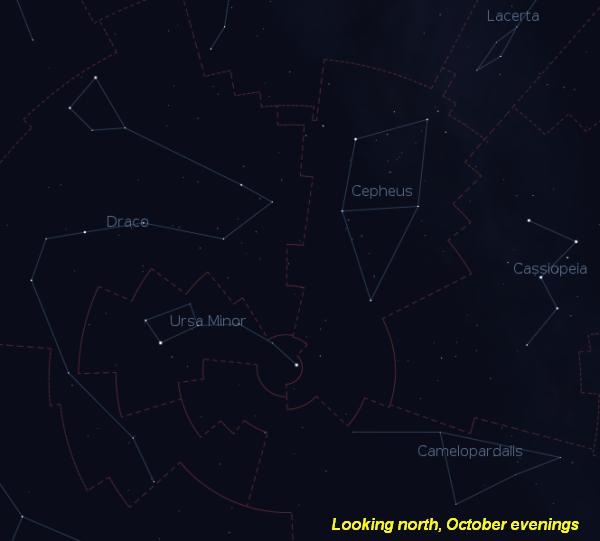¡SkyCaramba! Weekly astronomy blog for the week ending October 12, 2013
September’s clear weather made in North America allowed for a lot of meteor reports there. With so many clear nights, people could do more sky watching. Even people not paying particular attention to the sky could easily spot bright fireballs. And that was without a particularly active meteor shower for them to be associated with.
If there’s fair weather at your location in October, you may want to try to see meteors that appear to originate from the constellation Draco, the dragon. Maybe there’ll be a few big ones there too and the constellation will be a fireball breathing dragon!
Draco is a stretched out constellation partially circling the north celestial pole. It cannot be seen south of about 8° south of the equator. North of 25° north, it can be seen all year long unless you’re so far north it doesn’t get dark for weeks or months at a time.
This constellation has represented many dragons over the centuries. He was Tiamat to the Babylonians. In later stories, he was the monster slain by St. George. Whoever he is, the common theme to the stories is anarchy and chaos.
In Babylon, a legend was told of a goddess named Tiamat. Gods who came along long after she did challenged her authority and competed with her for the people’s reverence. She created fearsome monsters to show her power. She even turned herself into a dragon. Unfortunately for her, a hero named Marduk took control of the winds and caused them to blow into her mouth. The winds blew into her so hard, her body split. Half of Tiamat became the earth. The other half became the sky.
The Babylonian story lent a lot to the Greek story of the Titans battling the newer gods of Olympus. A dragon attacked Athena. But she defeated the creature and threw it up into the sky in such a way its body wrapped around the world’s axis.
Other Greek stories tell of a dragon killed at Thebes, one that guarded the Golden Fleece, and one that watched over the Golden Apples of the Hesperides. In Germany, opera author Richard Wagner wrote of the constellation in The Ring of the Nibelung.
The named stars of Draco are Thuban, Rastaban, Eltanin, and Atlais. To sky watchers of about 4,000 years ago, Thuban was the North Star. Because of a long slow wobble the earth makes as it rotates and revolves, Thuban is about 25° from the celestial pole now. Thuban is the Arabic name for the constellation. Rastaban means dragon’s head. Altais means serpent, but the star is sometimes called Nodus II, Latin for the second knot of four. The knots are kinks in the dragon’s twisted body.
So what’s the likelihood of a meteor shower or a few fireballs coming from Draco in 2013? It’s somewhat hard to predict. Comet Giacobini-Zinner leaves behind the dust trail that produces Draconid meteors. It was closest to the sun most recently in 2011. Earth is most likely to go through a freshly laid dust trail in the year or two after a comet’s close passage, and 2011 was a good year for the Draconids. However, this year, Earth passes through trails left in 1933 and 1946. While those were also great years for the Draconids, the comet dust has had decades to spread out.
You’ll have to go out yourself to see the Draconids for yourself and judge how good the show is. Here are some links to more information about them. ¡SkyCaramba!
http://earthsky.org/tonight/legendary-draconids-boom-or-bust
http://www.imo.net/draconids2011
http://www.earthmagazine.org/article/eyes-sky-watch-unpredictable-draconid-meteor-shower
